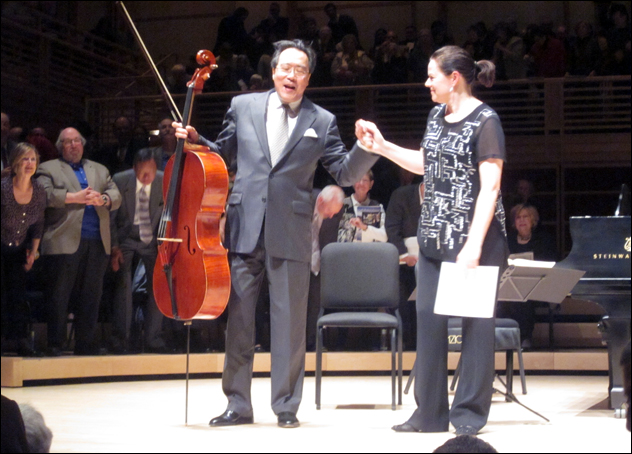

So Yo-Yo Ma’s deep into the third movement of Stravinsky’s Suite Italienne, right? And he’s plucking and pulling at the strings like a madman, and bouncing his bow all over the strings, and then he starts strumming the cello while grunting and heaving loudly and banging his head. And then, in the midst of all this chaos, Yo-Yo Ma twists his instrument sideways, stands up halfway out of his chair, throws his head backwards and at the same time glides the bow ever so softly to produce one entirely delicate, gossamer note that hangs in the air like silk.
You think you know Yo-Yo Ma; he’s the face of virtually every other PBS telethon, he’s a constant at awards shows and inaugurations, he’s the punchline for cheap standup comics because of his name. But as proven by a jaw-dropping performance at the Green Music Center on Saturday night, you don’t know Yo-Yo Ma until you see the man live, doing unearthly things with a cello and wresting a lifetime of emotion from his sheet music—which, incidentally, he ignores most of the time.
Yes, people wept. A woman sitting in the on-stage section repeatedly dabbed her eyes with a Kleenex. People also exploded in applause, even in the middle of a suite.
But the reigning effect was disbelief. Moments of sheer incredulity in the two-hour concert were nearly constant, and never more so than during the Astor Piazzolla composition, Oblivion. Ma playing Piazzolla is like Calder bending wire, or Paige throwing a fastball, or Child cooking Coq au Vin; he played the piece with every requisite drip of romanticism and then some. As the tension in the piece came to an end, Ma executed an impossibly sensitive harmonic in continuous descending glissando that slowly decrescendoed and thrillingly evaporated into nothing.
Pianist Kathryn Stott deserves just as much praise, and she and Ma shared a natural rapport. Take the third movement of de Falla’s 7 Canciones Populares Españolas, an eerie, atmospheric composition, when Ma leaned over and whispered in Stott’s ear, breaking her steely gaze into a smile. Or the entirety of Brahms’ Sonata No. 3 in D Minor, when Stott took cues from her peripheral vision of the placement of Ma’s bow in order to start and stop certain passages.
“Ladies and gentlemen,” announced Ma after the scheduled program, “Kathryn and I are so happy to play here… this is an unbelievable music room. There are riches that can be heard from this stage that only Kathy and I have shared for many, many years.”
Elgar’s “Salut d’Amour” followed, and wouldn’t you know it, a bonus second encore was on tap. Gershwin’s Prelude No. 1 brought the world travel of the program back to the United States, and brought a night for the ages to a close.
–
From the Notebook: The show sold out quickly, and on Craigslist people were offering $100 a seat. A man even stood out in front of the box office holding a homemade sign: “I NEED ONE TICKET.” 10 minutes before the show, he still hadn’t found one. . . . At a cocktail reception before the concert, donors and special guests were treated to a view of the still-unfinished Schroeder Hall, which so far has a stage and a raked floor inside a high-ceiling space but little else. $5 million more is needed to finish the room, which will provide a rehearsal and recital hall for students of SSU, and let’s hope one of the well-heeled attendees sees fit to make the donation that will directly benefit the students. . . . The Employer of the Year Award goes to Vinnie and Natalie Cilurzo of Russian River Brewing Co., who sat in the very back row. Funny thing—the couple had two more tickets to the concert, which they gave gratis to their employee, Gabe Rivera. His seats? Right up front in the second row, directly in the center. . . . (they traded places at intermission) . . . The pre-concert cocktail reception included Nancy Pelosi, Ernesto Olivares, Sandy Weill, Bruce Kyse and others, but it was Apollo 9 astronaut Rusty Schweickart who had the best story. Schweickart was at a Sacramento Symphony performance 30 years ago starring a then-relatively unknown Yo-Yo Ma; at the reception afterward, no one was interested in talking to the young cellist. So Schweickart introduced himself, and the two talked for nearly an hour. “I haven’t seen him since,” Shweickart said. . . . The connection between Sandy Weill and Yo-Yo Ma was evident on stage to those who noticed Ma lifting an eyebrow and motioning toward Weill’s box during the Stravinsky piece. But it became clear by the end of the concert, at the curtain call, when Ma and Weill literally blew kisses back and forth to each other. . . . Ma also joked about Weill’s $15m donation to the hall, quipping, “I want to assure you that they did not pay with a credit card. I think they have unlimited funds.” . . . At a post-concert gala dinner, Clive Gillinson, executive director of Carnegie Hall, said of the performance: “Many of you may say, ‘I think that was excellent cello playing.’ I can tell you, as someone who played cello growing up, I know that was excellent cello playing.” . . . Following Gillinson’s remarks, the new artists-in-residence at SSU, the Ariadne Trio, performed. How nerve-racking must it be—especially for cellist Saeunn Thorsteinsdottir—to perform 10 feet away from Yo-Yo Ma? No need to worry: afterward, the three women exited the stage and walked to the back of the room, whereupon Ma rose from his table, marched up to the trio and commended them on their performance. He stayed, joking and chatting with them for another 10 minutes, whatta guy. . . .


TRENDING:
.Live Review: Yo-Yo Ma at the Green Music Center












